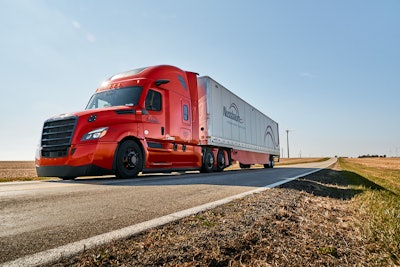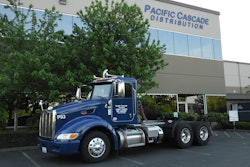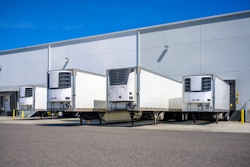
There’s still plenty of room for improving diesel fuel efficiency which as North American Council for Freight Efficiency Executive Director Mike Roeth makes clear is also an opportunity for cutting carbon.
“Decarbonizing trucking has become a very hot topic, but what we find in our work is far too often decarbonizing is only thought of in zero emission trucks, like you have to have an electric truck or a hydrogen fuel cell truck to decarbonize, which is really wrong. Anytime fleets burn less fuel to ship the same amount of goods, they are decarbonizing,” Roeth explained during a press event Tuesday covering NACFE’s 2022 Annual Fleet Fuel Study along with its new fleet Benchmarking Tool.
The 15 fleets that participated in NACFE’s Annual Fleet Fuel Study in 2021 (a total of 75,000 trucks) not only collectively saved $540 million last year compared to average trucks on the road, they also cut carbon.
“This report shows that they are decarbonizing the fleet right as we speak by operating these trucks with better fuel economy,” Roeth said, adding that he expects the 86 fuel saving technologies listed in the report to gain more attention as regulations tighten.
“Greenhouse gas rules are here to stay,” Roeth continued. “We have the zero emission rules that are coming in, but we expect a greenhouse gas phase three announcement in early 2023 sometime where the federal government will look at these fuel economy technologies out through the 2030s.”
[Related: Higher fuel prices, ESG driving growing interest in truck, trailer aero]
NACFE’s latest annual fuel study follows a three-year hiatus further hampered by COVID. During that time, NACFE found that the average fuel economy of the nation’s fleet rose from 5.98 to 6.24 MPG.
Fleets participating in NACFE’s fuel study from 2018 to 2021 enjoyed a higher fuel economy average of 7.24 MPG, the same figure revealed in the last fuel study. Roeth explained that fleet adoption of newer trucks with more fuel-saving technologies had driven seven consecutive year-over-year MPG increases averaging 2%, which leveled off to 7.24 MPG.
“Their new trucks versus their older trucks may have had a 7%, 8% or 10% improvement in fuel economy because they were raising the entire average of their collective fleet-wide fuel economy,” Roeth said. “That happened for about a dozen years until it started to level off in 2018, '19 and '20.”
Roeth still expects to see fuel economy improvements in diesel.
“We have not squeezed the last of the blood out of the turnip as they say. I mean, we've got a lot of fuel economy on diesel trucks still to harvest,” he said.
NACFE’s Director of Engineering and the fuel study’s author, Yunsu Park, said fuel saving technologies aren’t for diesel alone.
“In addition, we believe many of these technologies and practices will transfer to alternative fueled vehicles where they will help extend range,” Park said.
See how your fleet compares
NACFE’s 2021 Annual Fleet Fuel Study also gets for the first time a Benchmarking Tool that allows fleets to view and compare adoption rates of 86 fuel saving technologies among fleets that participated in the study.
Fuel saving categories include cabs; routes; chassis; idle reduction; powertrain; practices; tires/rolling resistance; tractor aero; and trailer aero.
After clicking on idle reduction, for example, 13 fuel-saving technologies are shown with varying degrees of adoption. Colored bar graphs further note speed of adoption. At the top of the list are ‘Anti idle Electronic Engine Controls’ with a 93% adoption rate.
To the right of each technology is a drop-down box that allows fleets to quickly compare their own trucks to NACFE’s fuel study participants by selecting either ‘In use’; ‘Not in use’; ‘Considering’; or ‘Not applicable.’ After considering all the fuel-saving measures, the Benchmarking Tool allows for a comparison report to be generated.
[Related: Great fuel economy requires time and sometimes money]
Fuel-saving powertrain technologies have the highest adoption rates with ‘Synthetic transmission oil’ and ‘Engine parameters set for fuel economy’ both topping that list with 100% adoption rates among participating fleets. ‘Automated manual transmissions’ are next at 97% followed by ‘Lower viscosity engine oil xW-30’ at 94%. Eleven other powertrain technologies are listed along with their adoption rates.
Some technologies were not adopted. For instance, fleets side-stepped fuel additives, mechanical turbo compounding and nitrogen filled tires.
“That's been in our study forever and really none of these fleets use it,” Roeth said of nitrogen filled tires. “But we keep hearing about it out in the field. It's one we actually talked about taking off. But we like to say, ‘Okay, let's keep it on just in case as we keep asking the fleets year over year.’”
No stranger to alternative powertrains and fuels, NACFE is gearing up for a busy carbon-cutting 2023 which will include its Run on Less Electric Depot; a thought leadership paper on transitioning to zero-emission powertrains; a guidance report on infrastructure for electric trucks to be released in February at the Technology Maintenance Council; a guidance report on hydrogen as a truck fuel; and the Run on Less Electric Depot Bootcamp.
 NACFE's interactive Benchmarking Tool was released today with its latest fuel study report. Fleets can see how they compare with other fleets that participated in NACFE's 2022 Annual Fleet Fuel Study. Fuel-saving chassis technologies are shown above.NACFE
NACFE's interactive Benchmarking Tool was released today with its latest fuel study report. Fleets can see how they compare with other fleets that participated in NACFE's 2022 Annual Fleet Fuel Study. Fuel-saving chassis technologies are shown above.NACFE












